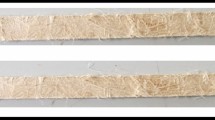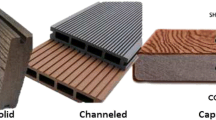Abstract
The present work deals with the influence of wood dust namely Rosewood and Padauk in the jute fiber-based epoxy composites. The work involves the fabrication of four different laminates of jute-epoxy composites using hand layup process with varying proportions of Rosewood and Padauk wood dust fillers compared with the composite in the absence of filler. The characterization of the mechanical and thermal properties was carried out by tensile, compression, flexural, shore D hardness, impact and thermogravimetric analysis as per ASTM. It is inferred from the test results that the mechanical properties got enhanced by the fine distribution of Padauk wood dust particles by improved adhesion with the matrix. The coarse structure of Rosewood dust over the composite improved thermal stability. Scanning Electron Microscopy was utilized to study the fractured interfaces of the mechanically tested composites. Furthermore, the developed composites affinity towards moisture and biodegradation were studied using water adsorption and biodegradability tests.














Similar content being viewed by others
References
Thakur VK, Thakur MK, Gupta RK (2014) Review: raw natural Fiber-based polymer composites. Int J Polym Anal Charact 19:256–271. https://doi.org/10.1080/1023666X.2014.880016
Wang X, Wang L, Lian W, Zhou A, Cao X, Hu Q (2018) The influence of carbon spheres on thermal and mechanical properties of epoxy composites. J Polym Res 25:1–7. https://doi.org/10.1007/s10965-018-1623-2
Oladele IO, Akinwekomi AD, Agbabiaka OG, Oladejo MO (2019) Influence of biodegradation on the tensile and wear resistance properties of bio-derived CaCO 3 /epoxy composites. J Polym Res 26:1–9. https://doi.org/10.1007/s10965-018-1676-2
Tavassoli F, Razzaghi-Kashani M, Mohebby B (2018) Hydrothermally treated wood as reinforcing filler for natural rubber bio-composites. J Polym Res 25:1–11. https://doi.org/10.1007/s10965-017-1394-1
Burzic I, Pretschuh C, Kaineder D et al (2019) Impact modification of PLA using biobased biodegradable PHA biopolymers. Eur Polym J 114:32–38. https://doi.org/10.1016/j.eurpolymj.2019.01.060
Ramesh P, Prasad BD, Narayana KL (2019) Morphological and mechanical properties of treated kenaf fiber/MMT clay reinforced PLA hybrid biocomposites. AIP Conf Proc. https://doi.org/10.1063/1.5085606
Agayev S, Ozdemir O (2019) Fabrication of high density polyethylene composites reinforced with pine cone powder: mechanical and low velocity impact performances. Mater Res Express. https://doi.org/10.1088/2053-1591/aafc42
Jain NK, Gupta MK (2018) Hybrid teak/Sal wood flour reinforced composites: mechanical, thermal and water absorption properties. Mater Res Express. https://doi.org/10.1088/2053-1591/aae24d
Khonsari A, Taghiyari HR, Karimi A, Tajvidi M (2015) Study on the effects of wood flour geometry on physical and mechanical properties of wood-plastic composites. Maderas Cienc y Tecnol 17:545–558. https://doi.org/10.4067/S0718-221X2015005000049
Vinod A, Vijay R, Singaravelu DL (2018) ThermoMechanical characterization of Calotropis gigantea stem powder-filled jute Fiber-reinforced epoxy composites. J Nat Fibers 15:648–657. https://doi.org/10.1080/15440478.2017.1354740
Kumaran P, Mohanamurugan S, Madhu S et al (2019) Investigation on thermo-mechanical characteristics of treated/untreated Portunus sanguinolentus shell powder-based jute fabrics reinforced epoxy composites. J Ind text:1–33. https://doi.org/10.1177/1528083719832851
Movva M, Kommineni R (2019) Effect of green gram husk Nanocellulose on Banana Fiber composite. J Nat Fibers 16:287–299. https://doi.org/10.1080/15440478.2017.1414658
Vijay R, Vinod A, Kathiravan R et al (2018) Evaluation of Azadirachta indica seed/spent Camellia sinensis bio-filler based jute fabrics–epoxy composites: experimental and numerical studies. J Ind text:1–26. https://doi.org/10.1177/1528083718811086
Arumuga prabu V, Uthayakumar M, Manikandan V, et al (2014) Influence of redmud on the mechanical, damping and chemical resistance properties of banana/polyester hybrid composites. Mater Des 64:270–279. doi: https://doi.org/10.1016/j.matdes.2014.07.020
Saw SK, Akhtar K, Yadav N, Singh AK (2014) Hybrid composites made from jute/coir fibers: water absorption, thickness swelling, density, morphology, and mechanical properties. J Nat Fibers 11:39–53. https://doi.org/10.1080/15440478.2013.825067
Sanjay MR, Yogesha B (2018) Studies on hybridization effect of jute/kenaf/E-glass woven fabric epoxy composites for potential applications: effect of laminate stacking sequences. J Ind Text 47:1830–1848. https://doi.org/10.1177/1528083717710713
Arpitha GR, Sanjay MR, Senthamaraikannan P, Barile C, Yogesha B (2017) Hybridization effect of sisal/glass/epoxy/filler based woven fabric reinforced composites. Exp Tech 41:577–584. https://doi.org/10.1007/s40799-017-0203-4
Sanjay MR, Arpitha GR, Senthamaraikannan P et al (2019) The hybrid effect of jute/Kenaf/E-glass woven fabric epoxy composites for medium load applications: impact, inter-laminar strength, and failure surface characterization. J Nat Fibers 16:600–612. https://doi.org/10.1080/15440478.2018.1431828
Vijaya Ramnath B, Junaid Kokan S, Niranjan Raja R et al (2013) Evaluation of mechanical properties of abaca-jute-glass fibre reinforced epoxy composite. Mater Des 51:357–366. https://doi.org/10.1016/j.matdes.2013.03.102
Mattos BD, Misso AL, De Cademartori PHG et al (2014) Properties of polypropylene composites filled with a mixture of household waste of mate-tea and wood particles. Constr Build Mater 61:60–68. https://doi.org/10.1016/j.conbuildmat.2014.02.022
Kiziltas EE, Kiziltas A, Gardner DJ (2016) Rheological and mechanical properties of ultra-fine cellulose-filled thermoplastic epoxy composites. BioResources 11:4770–4780. https://doi.org/10.15376/biores.11.2.4770-4780
Essabir H, Achaby MEI, Hilali EM et al (2015) Morphological, structural, thermal and tensile properties of high density polyethylene composites reinforced with treated Argan nut Shell particles. J Bionic Eng 12:129–141. https://doi.org/10.1016/S1672-6529(14)60107-4
Jamil MS, Ahmad I, Abdullah I (2006) Effects of rice husk filler on the mechanical and thermal properties of liquid natural rubber compatibilized high-density polyethylene/natural rubber blends. J Polym Res 13:315–321. https://doi.org/10.1007/s10965-005-9040-8
Abdul Khalil HPS, Issam AM, Ahmad Shakri MT et al (2007) Conventional agro-composites from chemically modified fibres. Ind Crop Prod 26:315–323. https://doi.org/10.1016/j.indcrop.2007.03.010
Fiore V, Scalici T, Vitale G, Valenza A (2014) Static and dynamic mechanical properties of Arundo Donax fillers-epoxy composites. Mater Des 57:456–464. https://doi.org/10.1016/j.matdes.2014.01.025
Ahmed KS, Mallinatha V, Amith SJ (2011) Effect of ceramic fillers on mechanical properties of woven jute fabric reinforced epoxy composites. J Reinf Plast Compos 30:1315–1326. https://doi.org/10.1177/0731684411420606
Srivastav AK, Behera MK, Ray BC (2007) Loading rate sensitivity of jute/glass hybrid reinforced epoxy composites: effect of surface modifications. J Reinf Plast Compos 26:851–860. https://doi.org/10.1177/0731684407076735
De Melo Monteiro GQ, Montes MAJR (2010) Evaluation of linear polymerization shrinkage, flexural strength and modulus of elasticity of dental composites. Mater Res 13:51–55
Lavoratti A, Zattera AJ, Amico SC (2019) Mechanical and dynamic-mechanical properties of silanized graphene oxide/epoxy composites. J Polym Res 26:1–10. https://doi.org/10.1007/s10965-019-1805-6
Aminullah A, Syed Mustafa S, Azlan N et al (2010) Effect of filler composition and incorporation of additives on the mechanical properties of polypropylene composites with high loading lignocellulosic materials. J Reinf Plast Compos 29:3115–3124. https://doi.org/10.1177/0731684410367532
Onuegbu GC, Igwe IO (2011) The effects of filler contents and particle sizes on the mechanical and end-use properties of snail Shell powder filled polypropylene. Mater Sci Appl 02:810–816. https://doi.org/10.4236/msa.2011.27110
Kokta BV, Raj RG, Daneault C (1989) Use of wood flour as filler in polypropylene: studies on mechanical properties. Polym Plast Technol Eng 28:247–259. https://doi.org/10.1080/03602558908048598
Zeriouh A, Belkbir L (1995) Thermal decomposition of a Moroccan wood under a nitrogen atmosphere. Thermochim Acta 258:243–248. https://doi.org/10.1016/0040-6031(94)02246-K
Kumar R, Kumar K, Bhowmik S, Sarkhel G (2019) Tailoring the performance of bamboo filler reinforced epoxy composite: insights into fracture properties and fracture mechanism. J Polym Res 26:1–15. https://doi.org/10.1007/s10965-019-1720-x
Raghavendra G, Ojha S, Acharya SK, Pal SK (2014) Jute fiber reinforced epoxy composites and comparison with the glass and neat epoxy composites. J Compos Mater 48:2537–2547. https://doi.org/10.1177/0021998313499955
Hyness NRJ, Vignesh NJ, Senthamaraikannan P et al (2018) Characterization of new natural cellulosic Fiber from Heteropogon Contortus plant. J Nat Fibers 15:146–153. https://doi.org/10.1080/15440478.2017.1321516
Kumar R, Hynes NRJ, Senthamaraikannan P et al (2018) Physicochemical and thermal properties of Ceiba pentandra bark Fiber. J Nat Fibers 15:822–829. https://doi.org/10.1080/15440478.2017.1369208
Bharath KN, Pasha M, Nizamuddin BA (2016) Characterization of natural fiber (sheep wool)-reinforced polymer-matrix composites at different operating conditions. J Ind Text 45:730–751. https://doi.org/10.1177/1528083714540698
Bharath KN, Sanjay MR, Jawaid M et al (2019) Effect of stacking sequence on properties of coconut leaf sheath/jute/E-glass reinforced phenol formaldehyde hybrid composites. J Ind Text 49:3–32. https://doi.org/10.1177/1528083718769926
Islam MS, Hasbullah NAB, Hasan M et al (2015) Physical, mechanical and biodegradable properties of kenaf/coir hybrid fiber reinforced polymer nanocomposites. Mater Today Commun 4:69–76. https://doi.org/10.1016/j.mtcomm.2015.05.001
Tajvidi M, Ebrahimi G (2002) Water uptake and mechanical characteristics of natural filler polypropylene composites. J Appl Polym Sci 88:941–946
Ichazo MN, Albano C, González J et al (2001) Polypropylene/wood flour composites: treatments and properties. Compos Struct 54:207–214. https://doi.org/10.1016/S0263-8223(01)00089-7
Jawaid M, Abdul Khalil HPS (2011) Cellulosic/synthetic fibre reinforced polymer hybrid composites: a review. Carbohydr Polym 86:1–18. https://doi.org/10.1016/j.carbpol.2011.04.043
Sathishkumar TP, Navaneethakrishnan P, Shankar S, Rajasekar R (2013) Characterization of new cellulose sansevieria ehrenbergii fibers for polymer composites. Compos Interfaces 20:575–593. https://doi.org/10.1080/15685543.2013.816652
Vignesh V, Balaji AN, Karthikeyan MKV (2016) Extraction and characterization of new cellulosic fibers from Indian mallow stem: an exploratory investigation. Int J Polym Anal Charact 21:504–512. https://doi.org/10.1080/1023666X.2016.1175206
Author information
Authors and Affiliations
Corresponding author
Additional information
Publisher’s note
Springer Nature remains neutral with regard to jurisdictional claims in published maps and institutional affiliations.
Rights and permissions
About this article
Cite this article
Dinesh, S., Kumaran, P., Mohanamurugan, S. et al. Influence of wood dust fillers on the mechanical, thermal, water absorption and biodegradation characteristics of jute fiber epoxy composites. J Polym Res 27, 9 (2020). https://doi.org/10.1007/s10965-019-1975-2
Received:
Accepted:
Published:
DOI: https://doi.org/10.1007/s10965-019-1975-2




